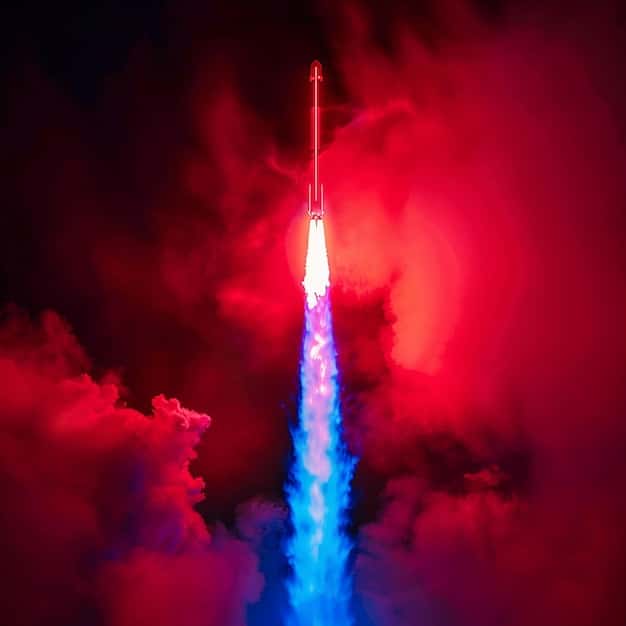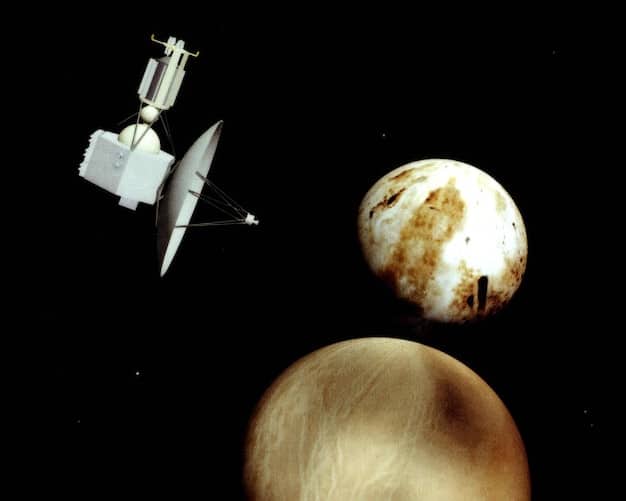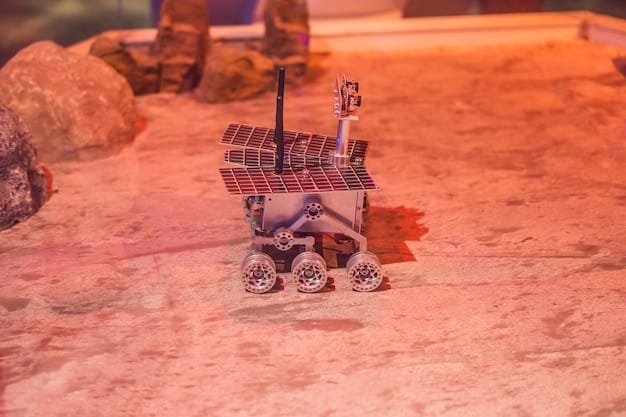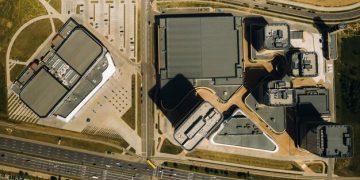Trump’s Space Policy: Opportunities for US Aerospace Companies

The Trump administration’s space exploration initiatives, driven by directives like Space Policy Directive 1, created significant opportunities for US aerospace companies through increased government funding, public-private partnerships, and a renewed focus on lunar and Martian missions.
The Trump Administration’s Space Exploration Initiatives: What Opportunities Exist for US Aerospace Companies? Trump administration made space exploration a key priority, setting ambitious goals and reshaping the landscape of the aerospace industry. This focus created a unique environment of innovation and opportunity for companies in the United States.
Unprecedented investments and policies of the Trump administration
The Trump administration marked a period of renewed interest and investment in space exploration. What were the key priorities and initiatives that defined this era?
Space Policy Directive 1: A Lunar Focus
At the heart of the Trump administration’s space policy was Space Policy Directive 1, which redirected NASA’s focus towards lunar missions. A key element of Space Policy Directive 1 was the Artemis program. This ambitious plan sought to return astronauts to the Moon by 2024, with the intention of establishing a sustainable presence there.
Increased Budget Allocations for Space Exploration
To support these ambitious goals, the Trump administration significantly increased NASA’s budget. This funding boost enabled NASA to accelerate the development of new technologies and infrastructure necessary for lunar missions, including the Space Launch System (SLS) rocket and the Orion spacecraft.

The increased funding and clearly defined objectives created numerous opportunities for US aerospace companies:
- Contract Opportunities: NASA issued a wave of contracts for the development of lunar landers, robotic explorers, and other technologies essential for the Artemis program.
- Public-Private Partnerships: The administration strongly encouraged public-private partnerships, allowing companies to collaborate with NASA on innovative projects and share the risks and rewards of space exploration.
- Technology Development: The focus on lunar missions spurred the development of new technologies in areas such as propulsion, robotics, and life support, creating a competitive advantage for US aerospace companies.
In conclusion, the Trump administration’s commitment to space exploration, particularly through Space Policy Directive 1 and increased budget allocations, laid the foundation for a surge in activity and innovation within the US aerospace sector.
The Artemis Program: A New Era of Lunar Exploration
The Artemis program was more than just a return to the Moon; it was a strategic initiative to establish a long-term presence and utilize lunar resources. This ambitious goal required significant private sector involvement.
Commercial Lunar Payload Services (CLPS)
The CLPS initiative was a cornerstone of the Artemis program, designed to outsource the delivery of scientific payloads to the lunar surface to commercial companies. These contracts provided guaranteed revenue streams for companies willing to invest in lunar lander technology, fostering competition and innovation in the process. Companies like SpaceX, Blue Origin, and Astrobotic landed significant CLPS contracts, allowing to refine technology and test capabilities.
Developing Lunar Infrastructure
Establishing a sustainable presence on the Moon requires more than just landing astronauts. It demands the development of infrastructure, including habitats, power generation systems, and resource extraction capabilities. This need created opportunities for companies specializing in these areas.

The Artemis program significantly changed the dynamics of space exploration, offering numerous advantages to US aerospace companies:
- Diversified Revenue Streams: Companies could secure contracts for both payload delivery and infrastructure development, creating diversified revenue streams and reducing reliance on traditional government contracts.
- Innovation and Competition: The competition for CLPS contracts and other opportunities incentivized companies to develop innovative technologies and solutions, fostering advancements across the aerospace sector.
- Global Leadership: By participating in the Artemis program, US aerospace companies could solidify their position as global leaders in space exploration, attracting talent and investment from around the world.
In summary, the Artemis program presented US aerospace companies with a unique opportunity to participate in a historic endeavor, drive innovation, and secure a leading position in the burgeoning lunar economy.
Deregulation and Tax Incentives: Fueling Growth
Beyond direct funding and programs, the Trump Administration implemented policies aimed at fostering a more business-friendly environment for the aerospace industry. How did these policies affect companies’ ability to innovate and grow?
Easing Regulatory Burdens
Recognizing that excessive regulations can stifle innovation and slow down progress, the Trump administration made efforts to streamline and reduce regulatory burdens on the aerospace industry. This included measures to expedite the approval process for new technologies and reduce compliance costs.
Tax Cuts and Investment Incentives
The Tax Cuts and Jobs Act of 2017 provided significant tax relief for businesses, including aerospace companies. The reduced corporate tax rate freed up capital that companies could reinvest in research and development, infrastructure upgrades, and workforce expansion. Additionally, the administration implemented investment incentives to encourage private sector investment in space-related ventures, further stimulating growth and innovation.
The regulatory reforms and tax incentives boosted the US aerospace sector by:
- Increased Investment: Tax cuts freed up capital for increased investments in R&D and infrastructure.
- Accelerated Innovation: Reduced regulatory burdens allowed for faster development and deployment of new technologies.
- Job Creation: A more business-friendly environment led to job creation and economic growth within the aerospace sector.
In essence, the Trump Administration’s deregulation efforts and tax incentives created a more conducive environment for US aerospace companies to thrive, fostering innovation and contributing to the overall competitiveness of the industry.
Space Force: A New Military Dimension
The establishment of the United States Space Force in December 2019 marked a significant shift in the nation’s approach to space security. How did this new military branch impact the aerospace industry?
Protecting US Assets in Space
The Space Force’s primary mission is to protect US assets in space, including satellites used for communication, navigation, and national security. This requires advanced technologies for surveillance, threat detection, and defense.
Opportunities for Aerospace Companies
The creation of the Space Force generated new opportunities for aerospace companies specializing in space-based technologies. The Space Force procures a wide range of equipment and services, including:
- Satellite Systems: The Space Force needs advanced satellite systems for communication, surveillance, and missile warning.
- Launch Services: The Space Force relies on commercial launch providers to deploy its satellites into orbit.
- Cybersecurity: Protecting space assets from cyber threats is a critical priority, creating opportunities for cybersecurity firms.
In short, the establishment of the Space Force created a new and growing market for US aerospace companies, fostering innovation in space-based technologies and strengthening the nation’s position in space security.
International Collaboration and Competition
The Trump administration’s space policies also had implications for international collaboration and competition in the space sector. How did these policies shape the global landscape of space exploration?
Prioritizing US Interests
While the Trump administration recognized the value of international collaboration in space, it also emphasized the importance of prioritizing US interests and maintaining a competitive edge. This approach led to a more assertive stance in international negotiations and a greater focus on protecting US intellectual property.
Competition with China and Russia
The administration viewed China and Russia as strategic competitors in space, and took steps to counter their growing influence. This included increasing investment in space-based technologies and strengthening alliances with like-minded countries.
The emphasis on competition had several consequences for US aerospace companies:
- Increased Investment: The focus on competition spurred increased investment in space-based technologies, benefiting companies involved in satellite development, launch services, and cybersecurity.
- Export Opportunities: The administration encouraged the export of US space technologies to allies, creating new market opportunities for US aerospace companies.
- Innovation: The competition with China and Russia incentivized companies to develop cutting-edge technologies to maintain a competitive edge.
Ultimately, the Trump administration’s approach to international relations in space created both challenges and opportunities for US aerospace companies, pushing them to innovate and compete on a global stage.
Challenges and Criticisms
Despite the opportunities, the Trump administration’s space policies were not without their challenges and criticisms. What were some of the drawbacks and controversies associated with these initiatives?
Sustainability and Long-Term Vision
One of the main criticisms was the lack of a clear long-term vision for space exploration beyond the Moon. Critics argued that the focus on lunar missions came at the expense of other important areas, such as Mars exploration and Earth science. Moreover, some questioned the sustainability of the Artemis program, given its ambitious timeline and budget requirements.
Budgetary Uncertainty
While the Trump administration initially increased NASA’s budget, there was always uncertainty about future funding levels. Changes in administration or economic downturns could potentially lead to budget cuts, jeopardizing long-term projects and investments. This uncertainty made it difficult for aerospace companies to make long-term plans and investments.
The challenges and criticisms associated with the Trump administration’s space policies highlight the importance of:
- Long-Term Planning: Developing a sustainable long-term vision for space exploration that extends beyond individual administrations.
- Budgetary Stability: Ensuring stable and predictable funding for NASA and other space agencies to enable long-term planning and investment.
- Balanced Approach: Striking a balance between different areas of space exploration, including lunar missions, Mars exploration, and Earth science.
While the Trump administration’s space policies created numerous opportunities for US aerospace companies, addressing these challenges and criticisms is essential for ensuring the long-term success and sustainability of the US space program.
| Key Point | Brief Description |
|---|---|
| 🚀 Artemis Program | Focused on returning astronauts to the Moon by 2024 and establishing a sustainable lunar presence. |
| 💰 Increased NASA Budget | Provided funds for technology development, lunar landers through contracts, public-private partnerships and other explorations. |
| 🏢 Space Force Creation | The creation the US Space Force generated new aerospace opportunities for aerospace companies especially those that have specialized in space based technologies. |
| 🤝 Public-Private Partnerships | These allowed companies to work with NASA. Sharing in both the risk and reward of space exploration endeavors. |
Frequently Asked Questions (FAQ)
▼
Space Policy Directive 1 was a key policy that redirected NASA’s focus towards returning to the Moon, with the ultimate goal of establishing a sustainable presence there.
▼
The Artemis Program required extensive private sector involvement for building lunar landers, habitats, and infrastructure. Resulting in the creation of new opportunities and new revenue streams.
▼
The Space Force boosted US technological investments in order to protect assets and other satellite systems.
▼
Yes, reduction of regulatory burdens and greater tax cuts gave way to faster development. This allowed for accelerated innovation and faster rates of employment.
▼
Trump’s administration pushed to export more technologies to allies. They also strengthened alliances, creating a competitive edge, and further innovation.
Conclusion
The Trump administration’s focus on space exploration led to significant opportunities for US aerospace companies. Through policies like Space Policy Directive 1, the Artemis program, and the establishment of the Space Force, the administration reshaped the space landscape, fostering innovation, competition, and growth within the industry. While challenges and criticisms remain, the era left a lasting impact on the trajectory of US space exploration.





